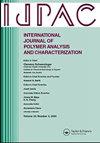频率和温度对天然橡胶和丁腈橡胶在不同温度下的粘弹性特性的影响:一项实验研究
IF 1.6
4区 工程技术
Q4 POLYMER SCIENCE
International Journal of Polymer Analysis and Characterization
Pub Date : 2025-04-03
DOI:10.1080/1023666X.2025.2453748
引用次数: 0
摘要
该研究旨在评估天然橡胶(NR)和丁腈橡胶(NBR)在减振应用中的频率和温度依赖的粘弹性特性。在室温至112℃范围内,对NR和丁腈橡胶进行低频动态力学分析(DMA)试验。采用广义Maxwell模型对实验数据进行拟合,并进行了振动试验,获得了固有频率、阻尼比和品质因子等动态特性。NR的损耗系数在80℃以上显著增大,而NBR的损耗系数在50℃以上减小。在较高的温度下,NR和NBR都表现出更快的弛豫,但NR具有更高的损耗因子,表明NR具有更好的阻尼能力。在60°C以上,NR的松弛强度增加,而NBR的松弛强度降低,两者的阻尼能力存在差异。NBR在第一固有频率处表现出较好的阻尼能力,而NR在第二和第三固有频率处表现较好。实验结果表明,NR更适合高温条件下的阻尼,而丁腈橡胶更适合低温条件下的阻尼。在较低温度下,NR的松弛模量低于丁腈橡胶,这使得NR在较高温度下的阻尼性能更好。该研究建议在需要高阻尼的高温应用中使用天然橡胶,在需要适度阻尼的低温应用中使用丁腈橡胶。本文章由计算机程序翻译,如有差异,请以英文原文为准。
Frequency and temperature dependent viscoelastic properties of natural rubber and nitrile butadiene rubber at different temperatures for vibration damping applications: an experimental study
The study aims to evaluate the frequency and temperature-dependent viscoelastic properties of natural rubber (NR) and nitrile butadiene rubber (NBR) for vibration damping applications. The dynamic mechanical analysis (DMA) tests were conducted on NR and NBR at low frequencies, from room temperature to 112 °C. The experimental data were fitted using the generalized Maxwell model, and vibration tests were conducted to obtain dynamic properties such as natural frequencies, damping ratio, and quality factor. The loss factor for NR increased significantly above 80 °C, while for NBR, it decreased above 50 °C. At higher temperatures, both NR and NBR exhibited faster relaxation, but NR had a higher loss factor, indicating a better damping ability. The relaxation strength of NR increased above 60 °C, whereas that of NBR decreased, highlighting the differences in their damping abilities. NBR showed greater damping ability at the first natural frequency, while NR performed better at the second and third natural frequencies. According to the experimental findings, NR proves to be better suited for damping in high-temperature conditions, while NBR is more suitable for low-temperature damping applications. The relaxation modulus of NR is lower than that of NBR at lower temperatures, leading to a better damping performance for NR at higher temperatures. The study recommends using NR for high-temperature applications where high damping is required and NBR for low-temperature applications that require moderate damping.
求助全文
通过发布文献求助,成功后即可免费获取论文全文。
去求助
来源期刊
CiteScore
3.50
自引率
5.30%
发文量
37
审稿时长
1.6 months
期刊介绍:
The scope of the journal is to publish original contributions and reviews on studies, methodologies, instrumentation, and applications involving the analysis and characterization of polymers and polymeric-based materials, including synthetic polymers, blends, composites, fibers, coatings, supramolecular structures, polysaccharides, and biopolymers. The Journal will accept papers and review articles on the following topics and research areas involving fundamental and applied studies of polymer analysis and characterization:
Characterization and analysis of new and existing polymers and polymeric-based materials.
Design and evaluation of analytical instrumentation and physical testing equipment.
Determination of molecular weight, size, conformation, branching, cross-linking, chemical structure, and sequence distribution.
Using separation, spectroscopic, and scattering techniques.
Surface characterization of polymeric materials.
Measurement of solution and bulk properties and behavior of polymers.
Studies involving structure-property-processing relationships, and polymer aging.
Analysis of oligomeric materials.
Analysis of polymer additives and decomposition products.

 求助内容:
求助内容: 应助结果提醒方式:
应助结果提醒方式:


